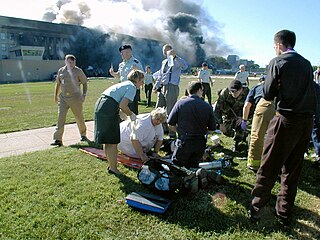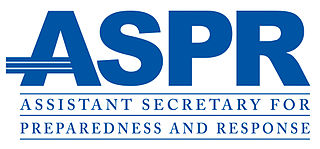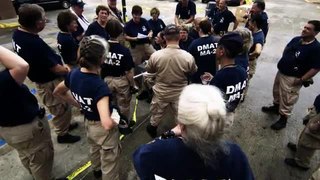Related Research Articles

The Federal Emergency Management Agency (FEMA) is an agency of the United States Department of Homeland Security (DHS), initially created under President Jimmy Carter by Presidential Reorganization Plan No. 3 of 1978 and implemented by two Executive Orders on April 1, 1979. The agency's primary purpose is to coordinate the response to a disaster that has occurred in the United States and that overwhelms the resources of local and state authorities. The governor of the state in which the disaster occurs must declare a state of emergency and formally request from the President that FEMA and the federal government respond to the disaster. The only exception to the state's gubernatorial declaration requirement occurs when an emergency or disaster takes place on federal property or to a federal asset—for example, the 1995 bombing of the Alfred P. Murrah Federal Building in Oklahoma City, Oklahoma, or the Space Shuttle Columbia in the 2003 return-flight disaster.

The Incident Command System (ICS) is a standardized approach to the command, control, and coordination of emergency response providing a common hierarchy within which responders from multiple agencies can be effective.

Emergency management, also called emergency response or disaster management, is the organization and management of the resources and responsibilities for dealing with all humanitarian aspects of emergencies. The aim is to prevent and reduce the harmful effects of all hazards, including disasters.
The National Incident Management System (NIMS) is a standardized approach to incident management developed by the United States Department of Homeland Security. The program was established in March 2004, in response to Homeland Security Presidential Directive-5, issued by President George W. Bush. It is intended to facilitate coordination between all responders. The system has been revised once, in December 2008. NIMS is the common framework that integrates a wide range of capabilities to help achieve objectives.

The National Disaster Medical System (NDMS) is a federally coordinated healthcare system and partnership of the United States Departments of Health and Human Services (HHS), Homeland Security (DHS), Defense (DOD), and Veterans Affairs (VA). The purpose of the NDMS is to support State, local, Tribal and Territorial authorities following disasters and emergencies by supplementing health and medical systems and response capabilities. NDMS would also support the military and the Department of Veterans Affairs health care systems in caring for combat casualties, should requirements exceed their capacity.
In the United States, the hospital incident command system (HICS) is an incident command system (ICS) designed for hospitals and intended for use in both emergency and non-emergency situations. It provides hospitals of all sizes with tools needed to advance their emergency preparedness and response capability—both individually and as members of the broader response community.

The United States’ Emergency Management Institute (EMI), of the United States Federal Emergency Management Agency (FEMA), serves as the United States’ focal point for the development and delivery of emergency management training. The emergency management training enhances the capabilities of state, territorial, local, and tribal government officials; volunteer organizations; FEMA's disaster workforce; other Federal agencies; and the public and private sectors to minimize the impact of disasters and emergencies on the American public. EMI curricula are structured to meet the needs of this diverse audience, with an emphasis on separate organizations working together in all-hazards emergencies to save lives and protect property. Particular emphasis is placed on governing doctrine, such as, the National Response Framework (NRF), National Incident Management System (NIMS), and the National Preparedness Guidelines. EMI is fully accredited by the International Association for Continuing Education and Training (IACET) and the American Council on Education (ACE). The instruction is based upon the principles of Emergency Management and instructional systems design. This instruction creates a framework within whole community to reduce vulnerability to hazards and to cope with disasters. EMI develops courses and implements training delivery systems to include residential onsite training; offsite delivery in partnership with Emergency Management training systems, colleges, and universities; and technology-based mediums to conduct individual training courses for Emergency Management and Response personnel across the United States.

Disaster medicine is the area of medical specialization serving the dual areas of providing health care to disaster survivors and providing medically related disaster preparation, disaster planning, disaster response and disaster recovery leadership throughout the disaster life cycle. Disaster medicine specialists provide insight, guidance and expertise on the principles and practice of medicine both in the disaster impact area and healthcare evacuation receiving facilities to emergency management professionals, hospitals, healthcare facilities, communities and governments. The disaster medicine specialist is the liaison between and partner to the medical contingency planner, the emergency management professional, the incident command system, government and policy makers.

The Office of the Assistant Secretary for Preparedness and Response (ASPR) within the United States Department of Health and Human Services that focuses on preparedness planning and response; building federal emergency medical operational capabilities; countermeasures research, advance development, and procurement; and grants to strengthen the capabilities of hospitals and health care systems in public health emergencies and medical disasters. The office provides federal support, including medical professionals through ASPR’s National Disaster Medical System, to augment state and local capabilities during an emergency or disaster.

On December 19, 2006, the Pandemic and All-Hazards Preparedness Act (PAHPA), Public Law No. 109-417, was signed into law by President George W. Bush. First introduced in the House by Rep. Mike Rogers (R-MI) and Rep. Anna Eshoo (D-CA), PAHPA had broad implications for the United States Department of Health and Human Services's (HHS) preparedness and response activities. Among other things, the act amended the Public Health Service Act to establish within the department a new Assistant Secretary for Preparedness and Response (ASPR); provided new authorities for a number of programs, including the advanced development and acquisitions of medical countermeasures; and called for the establishment of a quadrennial National Health Security Strategy.
The Emergency Data Exchange Language (EDXL) is a suite of XML-based messaging standards that facilitate emergency information sharing between government entities and the full range of emergency-related organizations. EDXL standardizes messaging formats for communications between these parties. EDXL was developed as a royalty-free standard by the OASIS International Open Standards Consortium.

In the United States, a public health emergency declaration releases resources meant to handle an actual or potential public health crisis. Recent examples include:
The California Governor's Office of Emergency Services is a California cabinet-level office responsible for overseeing and coordinating emergency preparedness, response, recovery and homeland security activities within the state. The agency was created by AB 38 (2008), superseding both the Office of Emergency Services (OES) and Office of Homeland Security (OHS).
The United States National Strategy for Homeland Security is a formal government response to the events of September 11, 2001 at the Pentagon and World Trade Center. The document issued by President George W. Bush outlines the overall strategic considerations for cooperation between the federal government, states, private enterprises, and ordinary citizens in anticipating future terrorism attacks as well as natural disasters and other incidents of national significance. The National Response Framework is the part of the homeland security national strategy that is a Comprehensive Emergency Management guideline for implementing scalable responses to disasters and other incidents of national significance.
Emergency management software is the software used by local, state and federal emergency management personnel to deal with a wide range of disasters and can take many forms. For example, training software such as simulators are often used to help prepare first responders, word processors can keep form templates handy for printing and analytical software can be used to perform post-hoc examinations of the data captured during an incident. All of these systems are interrelated, as the results of an after-incident analysis can then be used to program training software to better prepare for a similar situation in the future. Crisis Information Management Software (CIMS) is the software found in emergency management operation centers (EOC) that supports the management of crisis information and the corresponding response by public safety agencies.
The Integrated Planning System is a structured planning framework adapted from the US military's Joint Operational Planning and Execution System (JOPES) and was developed and released by the US Department of Homeland Security in January 2009.
Homeland Security Presidential Directive (HSPD)-8, National Preparedness, describes the way United States Federal agencies will prepare for an incident. It requires Department of Homeland Security to coordinate with other Federal agencies and with State, local, and Tribal governments to develop a National Preparedness Goal with Emergency management. Congressional laws enacted, following the wake of 9/11, which resulted in new developments in the way security was assessed and addressed in the United States, to prevent and respond to threatened or actual domestic terrorist attacks, disasters, and other emergencies by requiring a national domestic all-hazards preparedness goal. HSPD 5, HSPD-7, HSPD-8, and HSPD-8 Annex 1 are directives that deal with the preparedness goals.
The National Disaster Recovery Framework (NDRF) is a guide published by the US Government to promote effective disaster recovery in the United States, particularly for those incidents that are large-scale or catastrophic. The NDRF was released in September 2011 by the Federal Emergency Management Agency (FEMA).

Emergency Responder Health Monitoring and Surveillance (ERHMS) is a health monitoring and surveillance framework developed by a consortium of federal agencies, state health departments, and volunteer responder groups designed to address existing gaps in surveillance and health monitoring of emergency responders. The framework provides recommendations, guidelines, tools, and trainings to protect emergency responders during each phase of an emergency response, including pre-deployment, deployment, and post-deployment phases. ERHMS was designed to function within the Federal Emergency Management Agency's (FEMA's) National Incident Management System (NIMS), a systematic approach to emergency management. The ERHMS trainings satisfy Public Health Emergency Preparedness capability 14, "Responder Safety and Health."

Rear Admiral Meredith L. Austin is an active duty United States Coast Guard officer who has been serving as the Acting Deputy Assistant Secretary for Incident Command and Control within the Office of the Assistant Secretary Preparedness and Response (ASPR) since February 2020.
References
- National Response Framework Document, NRF Resource Center
- Dupuy, Trevor N. (1977). A Genius for War: The German Army and General Staff, 1897-1945 . London: Prentice Hall. ISBN 0-13-351114-6.
- Federal Emergency Management Agency (FEMA) Emergency Management Institute course IS-800.B National Response Framework, an Introduction
- "National Response Framework Released", United States Department of Homeland Security, Office of the Press Secretary, January 22, 2008.